In this article, we explore the five distinct stages that transform a potato seed into a successful potato crop, from the initial sprouting to the moment of harvest. The chart and infographics summarize the growing potatoes stages with the number of days of each stage. Also, you can download this guide in the “potato growth stages pdf” file.
Table of Contents
The Stages of Potato Growth
Once you’ve planted a seed potato, it progresses through five distinct stages of potato growth:
- Sprout Development
- Vegetative Growth
- Tuber Growth
- Tuber Bulking
- Maturation
Each stage is crucial in the overall growth and development of the potato plant. Understanding these stages is essential for successful potato cultivation.
Potato Growth Stages Day by Day
| Stage | Description |
| Sprout Development | Planting seed potatoes, nurturing emerging sprouts, ensuring optimal conditions for sprout development |
| Vegetative Growth | Photosynthesis begins, energy is channeled downward as stolons develop, the main stem and leaves grow, root system establishes |
| Tuber Growth | Tubers initiate above the original seed piece, grow out from the underground stem, store nutrients |
| Tuber Bulking | Tubers enlarge, sugars and starches accumulate, and optimal soil conditions crucial for the best yield |
| Maturation | Starch stored in tubers, tubers reach full size, outer layer toughens, leaves and stems above ground dry out |
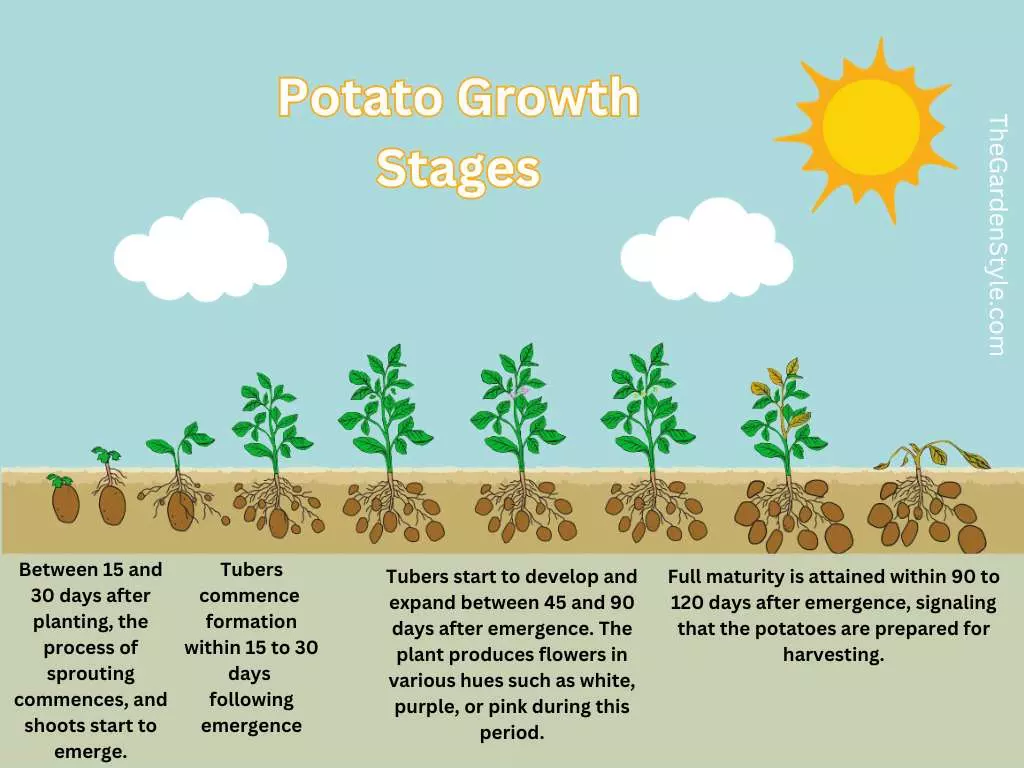
Stage 1: Early Stage Potato Growing Stages – Sprout Development
During the early stage potato growing stages, the seed potato or piece begins its transformation into a thriving plant. This stage is characterized by the emergence of sprouts from the seed potato, which will eventually grow into the above-ground portion of the potato plant. Factors such as temperature, moisture, and soil conditions play a crucial role in the successful development of these sprouts.
Proper soil moisture is essential for sprout development, as it provides the necessary hydration for the sprouts to grow. Additionally, maintaining a consistent temperature between 60-70°F (15-21°C) promotes optimal sprout growth. Adequate sunlight exposure is also important during this stage, as it stimulates photosynthesis and provides the energy needed for the sprouts to develop.
By ensuring favorable conditions for sprout development, potato growers can set a strong foundation for the subsequent stages of potato growth. This stage is vital for the overall success of potato cultivation, as healthy sprouts lead to robust plants and abundant yields.
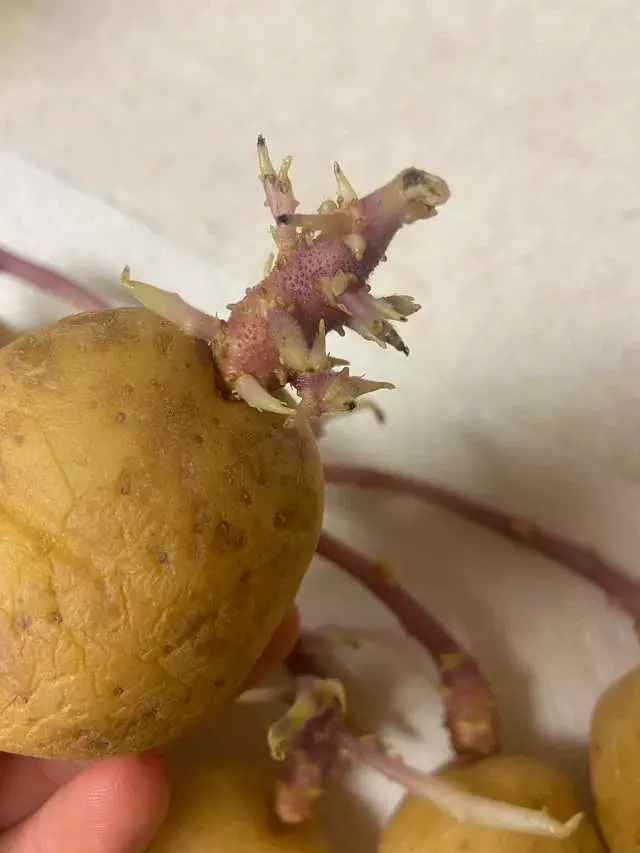
Stage 2: Vegetative Growth and Photosynthesis
During the vegetative growth and photosynthesis stage of potato cultivation, the leafy portion of the potato plant undergoes significant growth over four to five weeks. This growth is fueled by the process of photosynthesis, which is initiated by proper sunlight exposure to the above-ground leaves and stems.
As the plant grows, excess energy is directed downward to support the development of stolons, which serve as underground stems or “tubers.” These tubers grow above the original seed piece and extend along the entire length of the underground stem, acting as storage organs for nutrients. They play a crucial role in providing the plant with the necessary resources for future growth and development.
It is important to note that during this stage, the plant’s main stem ceases its upward growth and transitions to producing a flower bud. This marks an important milestone in the potato plant’s life cycle and sets the stage for the next stage of tuber growth.
Stage 3: Tuber Growth
During the tuber growth stage of potato cultivation, the process of tuber formation takes place. The development of stolons, the growth of shoots, and the significance of flowering characterize this stage. Tuber formation begins with the growth of shoots from the potato plant’s underground stem. These shoots develop into stolons, which are horizontal stems that grow along the soil surface.
Tubers start forming on the ends of these stolons, where they swell and develop into the familiar potato shape. The initiation of nutrient processes and tuber development is closely linked to the occurrence of flowering in potato plants. Flowering triggers the plant’s reproductive processes, which in turn stimulate the growth and development of tubers.
It is important to note that there is variation among potato varieties in terms of tuber formation. Some varieties are capable of producing tubers even without the occurrence of flowering. Understanding the process of tuber growth and the factors that influence it is essential for maximizing potato yield and quality.
Stage 4: Tuber Bulking
During the tuber bulking stage of potato growth, the newly formed tubers undergo a crucial process of enlargement. That is when sugars and starches accumulate, leading to the development of larger and more mature tubers. Optimal soil moisture, temperature, and nutrient availability play a significant role in achieving the best yield during this period.
It is essential to maintain cooler temperatures to ensure successful tuber formation. The most favorable conditions occur when daytime temperatures range from 60°F to 65°F (15°C to 18°C), with night temperatures remaining below 57°F (13°C). Cooler temperatures promote better tuber development and growth.
Conversely, warmer temperatures between 68°F and 84°F (20°C and 29°C) can have a negative impact on tuber formation, leading to a reduction in tuber size and yield. When temperatures exceed 84°F (29°C), tuber development ceases altogether. That is because warm weather increases respiration in the plant’s top part, resulting in a decrease in nutrient storage in the tubers below ground.
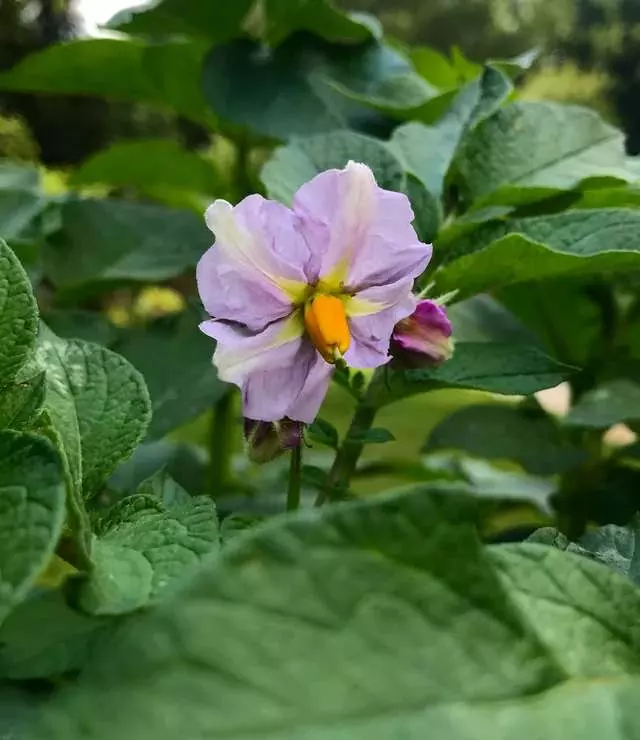
Stage 5: Maturation
During the maturation stage of potato growth, the tubers undergo significant changes that indicate their readiness for harvesting. As the tubers continue to grow, starch accumulates, causing them to enlarge and reach their full size. At the same time, the outer layer of the tubers toughens, allowing them to retain moisture and stay protected underground.
Above ground, the leaves and stems of the potato plant begin to dry out and die. That is a natural process as the tuber skins harden. Interestingly, even after the foliage starts to die, potatoes can remain underground. That allows the last bit of energy in the plant to be transferred to the tubers, resulting in their final growth and development.
One visual cue for determining the readiness of potatoes for harvest is the condition of the plant’s top. When the top of the plant dries out and turns yellow, it is a clear indication that the tubers are ready to be harvested. However, it’s important to note that the timeline for harvesting can vary depending on the potato variety. Generally, harvesting can take place anywhere between 12 and 18 weeks or more after planting, which translates to around 90 to 120 days.
It is crucial to harvest potatoes at the optimal time to ensure successful storage. That involves considering both the size of the tubers and the integrity of their skins. Potatoes that have reached their full size and have intact skins are more likely to have a longer shelf life and maintain their quality during storage. By paying attention to these factors, potato growers can achieve successful harvests and maximize the storage potential of their crops.
Learn more about When Are Potatoes Ready to Harvest, How To Harvest, and How To Store Potatoes After Harvesting.
Stages of Potato Growth Pictures
Here are the stages of potato growth pictures:
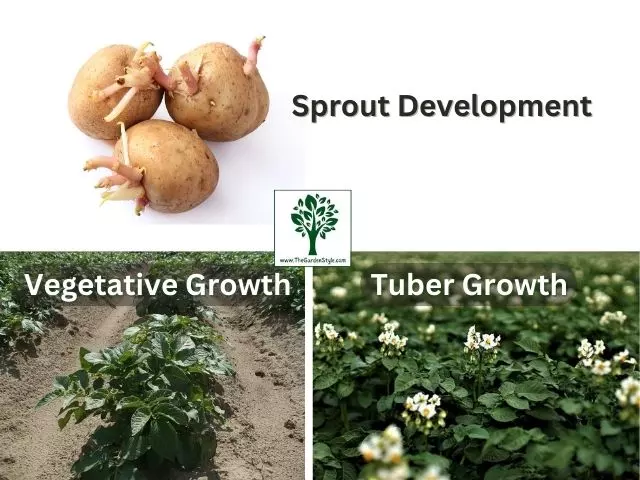
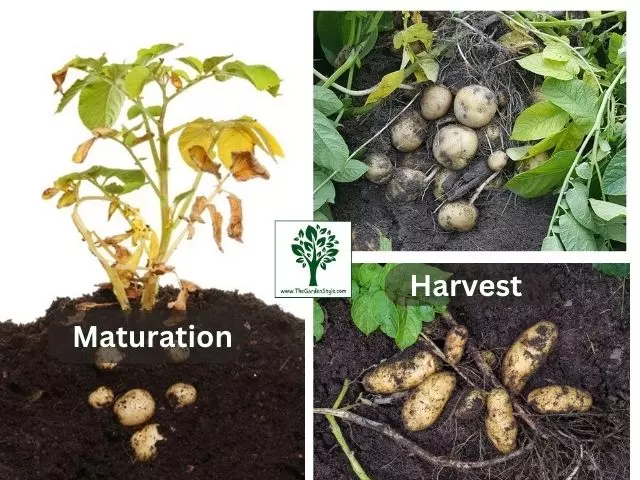
Variability in Potato Growth Stage Durations Across Varieties
Although the stages of growth of the potatoes are those mentioned above, the varieties of potatoes have different durations. Each variety has its own unique characteristics and growing considerations.
Russet Potatoes are one of the most widely grown potato varieties in the USA. They are typically planted in early spring and take about 90 to 120 days to mature. However, Yukon Gold Potatoes and Red Potatoes are typically ready for harvest in about 70 to 90 days.
Get the potato growth stages PDF by clicking here.

